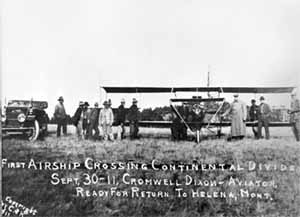Cromwell Dixon
Updated: August 7, 2020

Hundreds of people gathered at the Montana State Fairgrounds in Helena, Montana one tense autumn morning to see the famous “boy aviator,” Cromwell Dixon, take off in his attempt to fly his fragile Curtiss bi-wing plane over the Continental Divide. Other aviators had tried to meet this challenge before and had failed, but Cromwell was determined to prove his talents as a pilot and make a name for himself by succeeding where so many others before him had failed.
Known for his daring aerial acrobatics, Dixon was an aviation pioneer of the early 1900s. His vivid imagination and intense fascination with flying and aircrafts lead to his first invention when he was just 14 years old. Cromwell designed and built a “sky bicycle,” which was powered by pedals and a propeller and steered with a rudder connected to the handlebars. He made a balloon out of a huge silk bag and filled it with gas like contemporary hot air balloons and fastened it to a wooden frame. He became famous throughout the world for his ground-breaking invention, and people crowded around to see him bicycling in midair at county fairs.

Even though he wasn’t old enough, after his triumph with the “sky bicycle” Cromwell begged his mother to sign a contract with the Curtiss Exhibition Company of New York so that he could be an exhibition pilot. Reluctantly his mother agreed and on August 31, 1911 he was awarded his pilot’s license. At nineteen, he was the youngest licensed aviator in the world.
Soon Cromwell perfected the “Dixon Corkscrew,” an aerial maneuver in which he would spiral down from 8,000 feet and pull up and level off just before landing. This confident young man pushed the limits of his flying machine with a dangerous stunt like this, especially when early airplanes looked a bit like a wooden box and so much chicken wire… did not have anything close to the technology and safety standards of today’s aircrafts.
On September 30, Cromwell set off on his famous flight over the divide, anxious to win the $10,000 offered by local businessmen and others for the first aviator to cross the Continental Divide. Normally he’d wear his black-and-gray checkered cap turned backwards when flying, but that day he wore a wool aviator’s cap, flannel-lined aviator’s jacket, and fur gloves.

Excited spectators gathered at the Montana State Fairgrounds to watch Cromwell take off, and several people had already built a fire on the other side of the divide to help guide Cromwell to his landing spot and anxiously awaited his arrival. It was a beautiful, clear, windless autumn day and the audience watched him spiral up to 7,000 feet and soar out of sight. He flew west of Helena and landed successfully on the west side of Mullan Pass in a field. He made history that day by being the first person to fly an airplane over the Rocky Mountains.
On October 2, 1911, while performing his usual aerial stunts at the Spokane Fair, Cromwell’s bi-plane caught a strong, unexpected updraft. He plunged toward the ground and crashed and was crushed under the plane’s heavy engine.
Helena residents have not forgotten this young inventor and brave young pilot who amazed them with daring and historic flight. A campground on top of MacDonald Pass near the Continental Divide was named in his honor and today a plaque at the Helena airport commemorates his flight.
Updated: August 7, 2020

